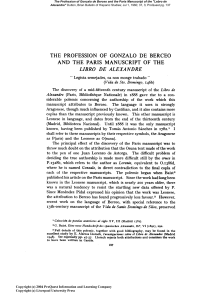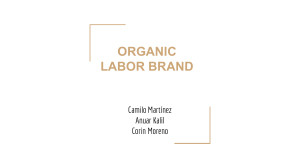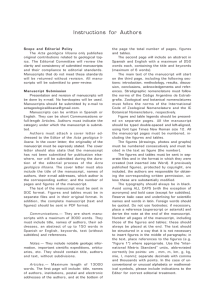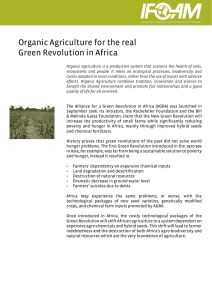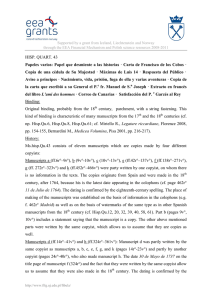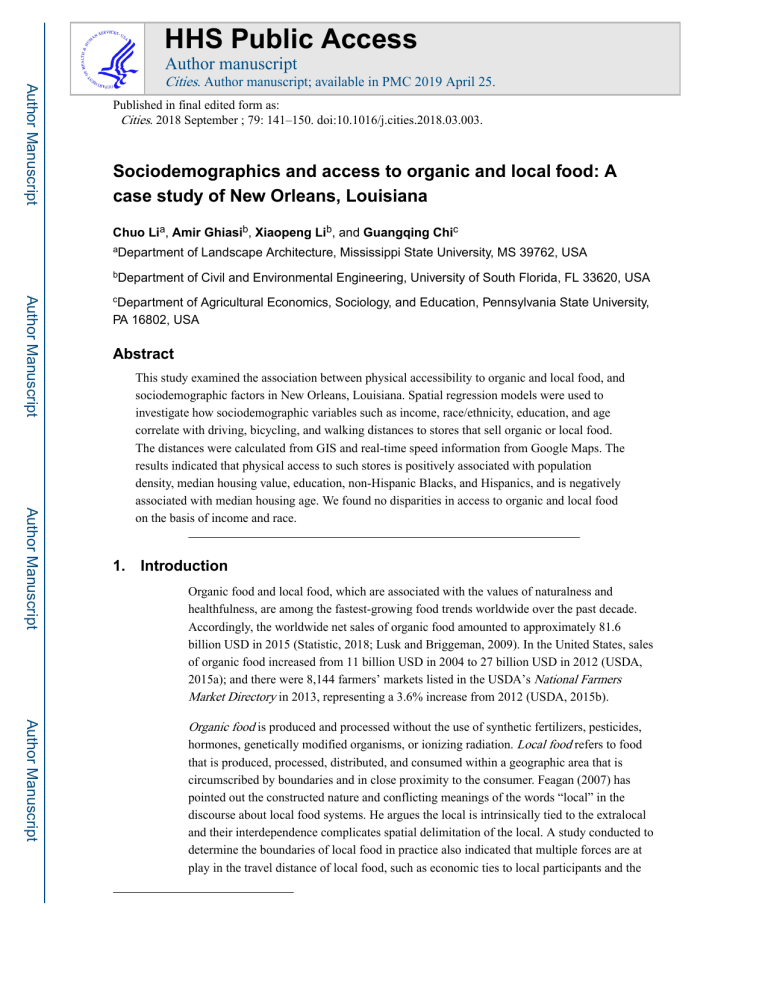
HHS Public Access Author manuscript Author Manuscript Cities. Author manuscript; available in PMC 2019 April 25. Published in final edited form as: Cities. 2018 September ; 79: 141–150. doi:10.1016/j.cities.2018.03.003. Sociodemographics and access to organic and local food: A case study of New Orleans, Louisiana Chuo Lia, Amir Ghiasib, Xiaopeng Lib, and Guangqing Chic aDepartment of Landscape Architecture, Mississippi State University, MS 39762, USA bDepartment of Civil and Environmental Engineering, University of South Florida, FL 33620, USA Author Manuscript cDepartment of Agricultural Economics, Sociology, and Education, Pennsylvania State University, PA 16802, USA Abstract Author Manuscript This study examined the association between physical accessibility to organic and local food, and sociodemographic factors in New Orleans, Louisiana. Spatial regression models were used to investigate how sociodemographic variables such as income, race/ethnicity, education, and age correlate with driving, bicycling, and walking distances to stores that sell organic or local food. The distances were calculated from GIS and real-time speed information from Google Maps. The results indicated that physical access to such stores is positively associated with population density, median housing value, education, non-Hispanic Blacks, and Hispanics, and is negatively associated with median housing age. We found no disparities in access to organic and local food on the basis of income and race. 1. Introduction Organic food and local food, which are associated with the values of naturalness and healthfulness, are among the fastest-growing food trends worldwide over the past decade. Accordingly, the worldwide net sales of organic food amounted to approximately 81.6 billion USD in 2015 (Statistic, 2018; Lusk and Briggeman, 2009). In the United States, sales of organic food increased from 11 billion USD in 2004 to 27 billion USD in 2012 (USDA, 2015a); and there were 8,144 farmers’ markets listed in the USDA’s National Farmers Market Directory in 2013, representing a 3.6% increase from 2012 (USDA, 2015b). Author Manuscript Organic food is produced and processed without the use of synthetic fertilizers, pesticides, hormones, genetically modified organisms, or ionizing radiation. Local food refers to food that is produced, processed, distributed, and consumed within a geographic area that is circumscribed by boundaries and in close proximity to the consumer. Feagan (2007) has pointed out the constructed nature and conflicting meanings of the words “local” in the discourse about local food systems. He argues the local is intrinsically tied to the extralocal and their interdependence complicates spatial delimitation of the local. A study conducted to determine the boundaries of local food in practice also indicated that multiple forces are at play in the travel distance of local food, such as economic ties to local participants and the Li et al. Page 2 Author Manuscript Author Manuscript locations of the trading partners (Trivette 2015). In addition to geographic proximity of supplier and consumer, local food is also defined by social and supply chain characteristics such as production methods (Thompson et al., 2008). For instance, local food enhances food security and promotes the economic, environmental, and social health of a particular place (Hinrichs, 2000). It is also associated with sustainable production and distribution practices that are environmentally friendly and reduce the use of synthetic chemicals and energybased fertilizers, as well as chemical and pesticide residue on food (Martinez et al., 2010). Similarly, organic food also has strongly local–spatial connotations, in addition to its association with ecologically sensitive conditions of production (Ilbery and Kneafsey, 1998). Thus, local food and organic food are significantly interconnected. The direct effect of the consumption of organic and local food on human health remains unclear (Magkos et al., 2006). However, it has been acknowledged that consumption of organic food would significantly reduce pesticide exposure and that local food has more nutrients and supports the local economy (Lu et al., 2008). Author Manuscript Previous studies have examined the role sociodemographic attributes play in the consumption of organic or local food, but the results on factors that influence consumer decisions have not been consistent (Nie and Zepeda, 2011; Bravo et al., 2013; Lea and Worsley, 2005). Education yielded the most important demographic characteristic that correlated with the consumption of organic food, with most studies suggesting that consumers with higher levels of education are more likely to purchase organic and local products (Dimitri and Dettmann, 2012; Zepeda and Li, 2007). The impact of other variables such as income, ethnicity, and the presence of children yielded mixed or contradictory findings (Dimitri and Dettmann, 2012; Durham, 2007; Loureiro et al., 2001). These studies shed some light on associations between sociodemographic factors and the consumption of organic and local food. However, little research to date has examined the relationship between sociodemographic attributes and access to organic and local food. It remains unclear if people have equal access to such food options and thus have equal opportunities to make food choices. Author Manuscript The main objective of the current study was to examine the association of accessibility to organic and local food stores with sociodemographic factors in New Orleans, Louisiana. This study used a relatively comprehensive list of variables obtained from the demographic literature to measure demographic characteristics and socioeconomic statuses. Existing research on food access used mainly a few sociodemographic variables such as education, race/ethnicity, and income, as addressed early in this section (Nie and Zepeda, 2011; Bravo et al., 2013; Lea and Worsley, 2005). Our variables also included population density (Ibeas et al. 2013), age, housing value (Dong 2015), and employment status (Greenwood 1975), which are other important measures of demographics and socioeconomic statuses used in the demography literature (e.g., Chi 2009). The current study also employed a set of innovative and comprehensive measures of real-time accessibility. It quantified the shortest distance a resident must travel to shop at an organic and local food store or market through any of three transportation modes—driving, bicycling, and walking—by using the Google Distance Matrix API. By utilizing spatial regression models, this study analyzed the association of organic and local food access with demographic characteristics and socioeconomic status. Cities. Author manuscript; available in PMC 2019 April 25. Li et al. Page 3 Author Manuscript These models helped improve the model’s fit to the data and provided further insights into the spatial effects of food access and socioeconomics. 2. Previous Studies Author Manuscript Author Manuscript Many studies have been conducted to investigate the ways in which socioeconomics might affect people’s physical access to healthy food—which is defined more broadly than local or organic food, as food that is believed to promote and sustain health, such as fruits and vegetables (Walker et al., 2010; Franco et al., 2008; Raja et al., 2008). Disparities in food access demonstrate the uneven distribution of healthy and unhealthy components of the food environment related to the variation of sociodemographic factors such as income and race/ ethnicity. For instance, the studies showed that residents living in poorer neighborhoods (those with a higher proportion of low-income and unemployed residents) had less access to supermarkets that offer a good variety of affordable and healthy food, compared with fastfood restaurants and small convenience stores (Morland et al., 2002b; Weinberg, 1995; Walker et al., 2010). In addition to income, race/ethnicity is associated with disparities in access to healthy food. Predominantly Black neighborhoods have six times more fast-food restaurants and four times fewer supermarkets than predominantly White neighborhoods (Block et al., 2004; Morland et al., 2002b). The literature identifies these disadvantaged geographic areas that lack access to affordable and nutritious food as “food deserts” (e.g., Larsen and Gilliland, 2008; Leete et al., 2012; Shannon 2013). The formation of the food deserts in U.S. cities, accordingly, was due to the growth of large chain supermarkets in more affluent areas, which forced the closure of smaller neighborhood grocery stores (Guy et al., 2004; Alwitt and Donley, 1997; Russell and Heidkamp, 2011). Factors such as changes in demographics in larger U.S. cities and the inaccurate perceptions about relatively disadvantaged areas have also contributed to the formation of food deserts (Walker et al., 2010). The demographics shift in the 1970s and 1980s, for instance, led to a significant decrease in more affluent households in the inner cities, which caused the closure of many supermarkets (Alwitt and Donley, 1997; Walker et al., 2010). Furthermore, the perceived images of the inner cities as areas of social disintegration, high crime rates, and poor life quality deterred the development of large supermarkets in these areas (Gittell and Thompson, 1999; Walker et al., 2010). Author Manuscript The research on food deserts and food access has also focused on the impact of the local food environment on residents’ dietary choices and ability to consume healthy and nutritious food (Walker et al., 2010). Food access affects food choice because people tend to make those choices based on the availability of food outlets in their near-neighborhood (Furey et al., 2001). In other words, the disparity in access to healthy food affects consumption of such food. Studies indicated that low-income and non-White ethnicity were associated with more fast-food and less fruit and vegetable consumption (French et al., 2000; James et al., 1997; Lewis et al., 2005). Convenient access to fast food, combined with decreased availability of healthy food might dictate food preference in Black and low-income communities, especially considering those residents’ limited access to transportation (Block et al., 2004). Studies also showed improved locational access to healthy food would increase its consumption, particularly among low-income groups (Larson et al., 2009; Rose and Richards, 2004; Morland et al., 2006; LeDoux and Vojnovic, 2014; Chen and Yang, 2014). Cities. Author manuscript; available in PMC 2019 April 25. Li et al. Page 4 Author Manuscript For example, Black Americans’ intake of fruits and vegetables increased by 32% with the presence of each additional supermarket in their census tract (Morland et al., 2002a). Similarly, previous studies found that the residents of neighborhoods with better access to organic food may be more likely to consume organic food (Curl et al., 2013; Nie and Zepeda, 2011). According to Dimitri and Dettmann (2012), households located within 5 miles of a Whole Foods Market have an increased probability of buying organic food. The findings of those studies demonstrate the association between access to organic and local food, and food choices. Author Manuscript Although these previous studies on food access examined the disparities of different communities in their ability to produce and consume healthy food, little research has focused on access to organic and local food. It has been acknowledged that the lack of access and/or inconvenience presents an obstacle to organic food purchase (Zanoli and Naspetti, 2002). The organic and local food movement plays a critical role in creating a sustainable food system and improving community food security. Thus, in addition to organic and local food consumption behavior, this study of access to organic and local food provides an important dimension to the literature on food justice and food access. 3. Methods 3.1 Data collection Author Manuscript Author Manuscript New Orleans, Louisiana, was selected as our study site because of its following characteristics. First, the city has a diverse population regarding race/ethnicity and other demographic characteristics. According to the U.S. Census Bureau, African-Americans were the majority of city residents at 59.1%; and non-Hispanic Whites constituted 31.0% in 2013. The share of both Hispanic (5.5% in 2013) and Asian (3.0% in 2013) populations has been increasing over the past decade. There are also wide gaps among the city’s population in income, education, and housing costs (Shrinath et al., 2014). This population diversity enabled our research to compare different sociodemographic factors and their correlations with the access to organic and local food. Second, organic and local food markets have played a significant role in the city’s life. The Crescent City Farmers Market in New Orleans reported $550,000 in direct sales for vendors and an economic impact of $450,000 on the market’s surrounding neighborhoods and regions in 2001 (Hughes et al., 2008). The popularity of organic and local food markets in the city provided relatively varied geographic locations of the food stores for an analysis of the residents’ access. Third, as for transportation modes, New Orleans is multi-modal, with a significant amount of pedestrian and biking trips. The city has a relatively level landform and a moderate temperature, and most neighborhoods are located within 10 miles of the city center. Because the historic fabric has been well preserved, the city is dominated by grid street networks with sidewalks. These facts contribute to the popularity of nonmotorized transportation in the city. New Orleans is known to be one of the major U.S. cities in which bicycle commuters have a relatively notable share of urban trips (Dill and Carr, 2003). After the hurricane in 2005, several bike lanes were installed in the city, which led to a significant increase in cycling trips (Parker et al., 2011). This characteristic allowed us to explore the variations of access to organic and local stores though different transportation modes. Cities. Author manuscript; available in PMC 2019 April 25. Li et al. Page 5 Author Manuscript In our study, all 405 census tracts of the New Orleans metropolitan area were included (indexed by j = 1, 2… 405). The data for each census tract for the 14 demographic and socioeconomic variables used in the analysis were derived from 2008–2012 American Community Survey (ACS) 5-year estimates. In this study, we selected a relatively comprehensive list of variables measuring demographics and socioeconomic status that have often been used in the demographic and sociological literature (Chi, 2009). These variables included population size, population density, age (the young and the old), race/ethnicity (non-Hispanic White, non-Hispanic Black, and Hispanic), level of education (high school, bachelor’s degree, and graduate degree), median household income, employment rate, median housing value, and median housing age. These variables and their descriptions are provided in Table 1. Author Manuscript We initially identified candidate organic food stores and markets in New Orleans by searching the Internet via Google, Yahoo, and Bing. Nineteen keywords were used for searching, such as “New Orleans organic food stores,” “New Orleans organic food markets,” “New Orleans farmers markets,” “New Orleans organic farmers,” “Louisiana organic food distributors,” and “Louisiana organic food vendors.” To verify the selection, we compared it with the results obtained through a search of the online phonebook YellowPages.com. We then contacted each candidate store via email or phone to verify that it sells organic or local food to the public, the store address, and the number of days open each month and each year. This approach, however, is limited by the fact that some small farmers markets or stores may not have websites or phone numbers listed. It also might exclude the local farmers who deliver their produce only to individual households or who provide produce for registered customers to pick up. The longitude and latitude for each store were determined based on their locations on Google Maps (https://www.google.com/maps). We eventually identified 19 organic and local food stores in the area, as shown in Fig. 1, 2, and 3. Those stores consist of two supermarkets, 14 farmers markets, two health food stores, and one food coop. Author Manuscript 3.2 Real-time network accessibility Author Manuscript To estimate the distance between the organic and local food stores and the population in each census tract, the tracts were aggregated to their centroids. This assumption may have an impact on the accuracy of the models because some of the census tracts appear to be larger in size than others (Fig. 1, 2 and 3). The limitation was due to a lack of more detailed figures on statistical units within these census tracts. In addition, the larger census tracts are located mostly in lower- or zero-density areas with longer distances to organic and local food stores, and thus such aggregation does not cause much error in distance estimation. Overall, our approach of aggregation is considered reasonable based on available data. Further, when data with higher resolution become available in the future, the proposed methodology is directly applicable to such data in future studies. We used the Google Distance Matrix API1 to estimate the distance between each censustract centroid (j) and each organic or local food store (k), denoted by d jk. The input to this 1https://developers.google.com/maps/documentation/distancematrix/ Cities. Author manuscript; available in PMC 2019 April 25. Li et al. Page 6 Author Manuscript API consisted of 405 sets of geographic coordinates (latitudes and longitudes from the World Geodetic System of 1984 [WGS84]) of the census tracts (origins) and 19 sets of coordinates for the organic and local food stores (destinations)—that is, 7,695 origin– destination (OD) pairs. We considered three transportation modes for each OD pair: driving, bicycling, and walking. Because very limited areas in the New Orleans metropolitan are covered by the public transit system, this mode of transportation is not considered for the analyses. For each transportation mode, we obtained a 405 × 19 matrix of the OD distances, denoted by d jk 3.3 j = 1, …, 405 . Data analysis The accessibility to organic and local food by residents of each census tract was measured by the shortest distance between the centroid of a census tract j and its organic and local Author Manuscript food stores by means of the three transportation modes, i.e., d j ≔ min d jk, k = 1,2…19 . The shorter the distance d j, the easier the access of an average household in census tract j to organic and local food. In Fig. 1, 2, and 3, the census tracts are colored according to their distance to the nearest organic and local food store (i.e., d j, ∀ j = 1,2, …, 405) for driving, bicycling, and walking transportation modes, respectively. The gray census tracts represent the tracts where no routes to the stores existed for the corresponding transportation modes. It is worth mentioning that the population in most of the mentioned census tracts are zero because they are located in natural, uninhabitable areas (e.g., lake and wildlife areas). Author Manuscript Author Manuscript We first employed a standard linear regression model to examine the correlation between the census-tract variable matrix V and the accessibility-measure vector D. However, standard regression models take no account of spatial variation in their analysis of relationships between variables (Abadi and Kermanshah, 2014). Therefore, because we theorized that geographic correlation may exist between the accessibility measures of neighboring census tracts, we also experimented with two spatial regression models, a spatial lag model and a spatial error model, depending on the type of spatial dependence in the standard regression model residuals. The diagnostics included Moran’s I test for errors, Lagrange multiplier (LM) tests for lag dependence and error dependence, and robust LM tests for lag dependence and error dependence. LM tests assist in detecting spatial dependence in the form of an omitted spatially lagged dependent variable and/or spatial error dependence (Anselin, 1988). Robust LM tests assist in diagnosing the pertinence of the spatial dependence if the LM tests for both the lag and error dependences are significant (Anselin et al., 1996). Based on the results of the spatial dependence tests, the appropriate spatial regression models were specified to further examine the association of census-tract variables with accessibility. The spatial lag model (SLM) is specified as follows: D = ρDW + β ⋅ V + ε Cities. Author manuscript; available in PMC 2019 April 25. (1) Li et al. Page 7 Author Manuscript where ρ is a spatial lag parameter, W ≔ W i j i = 1, …, 405 , j = 1, …, 405 is a spatial weights matrix representing the geographical proximity between each pair of census tracts i and j, β is a vector of coefficients for the variables in V, and ε represents the vector of error terms that are independent but not necessarily identically distributed (Chi and Zhu, 2008). The weights matrix W was obtained in the following way. We set W i j = 1 if the great-circle distance between the centroids of census tract i and j was smaller than a prespecified distance threshold d, or W i j = 0 otherwise. This threshold was set as the minimum distance required to ensure that each census tract had at least one neighboring census tract. Using the statistical software GeoDa, we calculated the weights matrix for the spatial regression analysis. We then applied the spatial error model (SEM), defined as follows: Author Manuscript D = β⋅V + u u = ρWu + ε (2) (3) where ρ is a spatial error parameter, W is the same spatial weights matrix as that in the spatial lag model, ε is an uncorrelated and homoscedastic error term that is defined in the same way as the spatial lag model, and u is a derived error vector specified in an autocorrelated form in Equation 3. Author Manuscript It should be noted that spatial autocorrelation in the spatial lag model was modeled by a linear relation between the response variable (D) and the associated spatially lagged variable (WD), whereas spatial autocorrelation in the spatial error model was represented by an error term (u) and the associated spatially lagged error term (Wu). A significant spatial lag term indicates strong spatial dependence of the dependent variable, while a significant spatial error term indicates spatial correlation of the error terms (u), which may be due to key explanatory variables that are not included in the model. For the calculation of W, we considered great-circle distances between census-tract centroids. This assumption is reasonable for neighboring tracts that are relatively close to each other. For cases with greater distances, there are higher probabilities that the corresponding W’s elements are zero, so this assumption will not significantly impact our results. Author Manuscript 4. Results During the process of fitting both the standard regression model and two spatial regression models to the data set, the indicators such as coefficient, standard error, and p-value (probability) were calculated. We tested the null hypothesis that the coefficient for each independent variable is equal to zero (no effect). With a 95% confidence interval, a low pvalue indicates the null hypothesis could be rejected, and the independent variable is Cities. Author manuscript; available in PMC 2019 April 25. Li et al. Page 8 Author Manuscript significant. In other words, a variable that has a low p-value is likely to be a meaningful addition to our model because changes in the independent variable’s value are related to changes in the response-dependent variable. Conversely, a larger (i.e., insignificant) p-value suggests that changes in the independent variable are not associated with changes in the dependent variable. Author Manuscript In this study, all variables were used to fit the data in the first step; and only the variables that were significant (with the p-value less than or equal to 0.05) in at least one of the models were kept for running the models in the second step. Therefore, some insignificant variables remained in some of the models so as to have common variables in the models. We ran standard linear regression models for the three transportation modes of walking, bicycling, and driving. The results are presented in Tables 2, 3, and 4. The Moran’s I tests for errors indicate statistically significant spatial autocorrelation in the model residuals. The LM tests and robust LM tests for lag dependence and error dependence indicate there exist both spatial lag and spatial error dependence in standard regression model residuals for all three transportation models. Therefore, we chose to run both spatial lag and spatial error models for all transportation models. The results are presented in Tables 2, 3, and 4. The Rsquared and Akaike information criterion (AIC) indicate that the spatial regression models are better fitted to data than are the standard regression models. In summary, the following relationships between demographic factors and accessibility to organic and local food can be deduced: Author Manuscript Author Manuscript 1. Population density: The results indicate that population density is negatively associated with distance to the nearest store that sells organic or local food, via all three transportation modes (walking, bicycling, and driving). This finding means that such stores tend to be located closer to areas with higher population density. 2. New housing units: Census tracts with a higher percentage of new housing units tend to have longer distances to the nearest store that sells organic or local food, via all three transportation modes. This finding indicates that such stores are less accessible in areas that have more housing units built in 1970 or later. 3. Housing value: Areas with a higher median value of housing units tend to have shorter distances to the nearest store that sells organic or local food, via all three transportation modes, which suggests that such stores tend to be located closer to housing units with higher median values. 4. Non-Hispanic Blacks and Hispanics: The percentage of non-Hispanic Blacks and the percentage of Hispanics are negatively associated with the distance to the nearest store that sells organic or local food, via all three modes of transportation. This finding means that areas with higher percentages of nonHispanic Blacks and Hispanics have better locational access to stores that sell such food. We also tested the correlation between the percentage of non-Hispanic Blacks and Hispanics with population density and found no significant correlation between these two pairs of variables. Therefore, the relationship Cities. Author manuscript; available in PMC 2019 April 25. Li et al. Page 9 Author Manuscript between the accessibility measure and the percentage of non-Hispanic Black and Hispanics is not related to population density. 5. 5. Bachelor’s degree: The percentage of the population with a bachelor’s degree is negatively associated with the distance to the nearest store that sells organic or local food, via all three transportation modes. This finding suggests that areas with a higher percentage of the population with a bachelor’s degree tend to have better locational access to such stores. Discussion Author Manuscript We implemented standard regression modeling and two types of spatial regression—spatial lag and spatial error—to explore the relationship between sociodemographic factors and accessibility to stores that sell organic or local food. Our results show better performance for spatial regression models in comparison with the standard regression model. Author Manuscript The two spatial regression models have good fits, as indicated by their high R-squared values. Six sociodemographic factors (population density, percentage of new housing units, median house value, percentage of non-Hispanic Blacks, percentage of Hispanics, and percentage of people with a bachelor’s degree) correlate with locational access to stores and markets that sell organic and local food. We found no indication of poor access to those stores in the less advantaged neighborhoods: household income and employment are not significantly associated with distance to such stores. This finding is consistent with some of the previous studies that found less advantaged groups have no less locational access than more advantaged groups to farmers markets (Pearson and Wilson, 2013; Widener et al., 2011). It may be explained by lower food prices offered by farmers markets (Pearson and Wilson, 2013). Evidence suggests the introduction of farmers markets could lead to a decrease in fruit and vegetable prices in neighboring supermarkets because of their competitive impact (Larsen and Gilliland, 2009). Thus, improved locational access to farmers markets helps to increase fruit and vegetable intake in low-income communities and areas with limited access to retailers of healthy food (Evans et al., 2012). In addition, although some specialty food stores might sell more expensive organic food, studies suggest household income has extremely minor effects on the consumption of organic food (Curl et al., 2013; Lockie et al., 2004). Author Manuscript Although race/ethnicity appears to be a strong indicator associated with disparity in access and consumption of healthy food, our study shows that areas with a higher percentage of Black and Hispanic residents have better locational access to stores that sell organic or local food. According to Zepeda et al. (2006), although Blacks have lower familiarity than Whites with organic food, they are more receptive to and positive about organic food and are also more accepting of price premiums for organic food. But it should be pointed out that the Zepeda et al. (2006) study was a focus group study, with a relatively small sample of 43 participants, which limits generalization of the findings. Another study also suggested that Hispanic and Asian households are more likely to buy organic products than White households, while Black households are less likely to buy organic products. But the link is weak (Dimitri and Dettmann, 2012). The differences in organic food purchasing behaviors Cities. Author manuscript; available in PMC 2019 April 25. Li et al. Page 10 Author Manuscript might be partly explained by the distinct diet patterns of each racial group, although the differences in dietary patterns among racial groups (as indicated by the Diet Quality Index) have narrowed over time (Popkin et al., 1996). Despite the differences, our results show relatively equal access to organic and local food regardless of differences in household income, employment status, and race/ethnicity. This finding might have a great implication for program planning and policy development aimed at improving access to healthy and affordable food in the food desert areas. A community- or city-level incentive and promotion of farmers markets and small local and organic food stores in these areas will be helpful when thinking about ways to increase healthy food access for the low-income and ethnic minorities. Author Manuscript The correlation between population density, median housing age, and median housing value and access to organic and local food suggests that the organic and local food stores and markets tend to be located near older neighborhoods with higher population densities and house values. One of the reasons might be the relatively small number of stores in New Orleans that sell organic or local food. Although organic food has a high public profile, the number of people who regularly shop for organic or local food is limited (Dimitri and Greene, 2002). Thus, to achieve and sustain a successful business, visibility and easy access might be a priority for owners of stores and markets that sell organic or local food. Furthermore, the organic and local food movement promotes healthy eating and environmental sustainability, which are associated with smart growth and environmental justice. Thus, locating proximate to walkable historic districts instead of newer neighborhoods created by urban sprawl tends to support the ethic ideologies of the organic and local food movements. Author Manuscript Author Manuscript Previous research showed that education has a strong correlation with the consumption of organic produce (Dimitri and Dettmann, 2012; Curl et al., 2013). People with a higher level of education were significantly more likely to consume organic produce. Research has also found that psychographic factors such as health, environmental and animal welfare concerns are high internal locus of the choice of organic foods by consumers. Specifically, perceived environmental benefits, healthy diet, and values related to nature and equality were found to positively predict organic food purchase (Makatouni, 2002; Hughner et al., 2007; Lea and Worsley, 2005). But it remains unclear that whether education is correlated with the psychographic factors of values, health attitudes, and lifestyles. Although Lea and Worsley (2005) suggested that those consumers with a university education being less likely than those without to agree that there was a risk involved in eating organic food, further studies are needed to better understand how and to what extent education impact on consumers’ organic food beliefs and consumption behaviors. Our study indicates that education is associated with locational access to stores that sell organic or local food. Those stores tend to be located near areas that have a higher percentage of residents with a bachelor’s degree. But this might be contributed by the factors that people with higher education tend to have more pro-organic food attitudes. Thus our study shows the need for future research to provide clarity on the relationships between education, psychographic factors, and locational access to organic food. Cities. Author manuscript; available in PMC 2019 April 25. Li et al. Page 11 Author Manuscript Our spatial lag and spatial error models provided further insights into the association of organic and local food access with sociodemographic factors. The statistically significant and positive spatial lag effects detected by the spatial lag models suggest that organic and local food access in a census tract is positively associated with that in its neighboring tracts (Chi and Zhu, 2008). The statistically significant and positive spatial error effects detected by the spatial error models helped control for factors that have significant effects on food access but are not included in the model (Chi and Zhu, 2008). 6. Conclusion Author Manuscript Author Manuscript Our study used comprehensive data provided by the American Community Survey and a customized GIS program to examine the association between sociodemographic factors and locational access to organic and local food in the New Orleans metropolitan area. Because New Orleans is a city with high diversity (in terms of race/ethnicity, income, and educational attainment), the results are more generalizable to similar cities with a high diversity than those with a low diversity. The analysis indicated that some factors were significantly associated with locational access to organic and local food: education, population density, median house age, median house value, non-Hispanic Blacks, and Hispanics. Specifically, we found that higher education, higher population density, higher house value, older houses, and non-Hispanic Blacks and Hispanics were associated with better locational access to organic and local food. Our models did not find a statistically significant relationship between median household income or employment status and access to organic and local food. This finding suggests that access to organic and local food is relatively pro-equity in terms of income and race/ethnicity, which added an important dimension to the food desert literature. Further research on this topic to compare organic and local food access for the residents who reside in a food desert and a food oasis is warranted to better understand of the correlations between sociodemographic factors and access to organic and local food. It will provide a basis for policy and social interventions such as promoting farmers markets in the food deserts to improve local and organic food access. In addition to an accessibility analysis, this study presented a performance analysis of the standard linear and the spatial lag and spatial error regression models for the purpose of comparing their performances for accessibility analyses. It showed that spatial regression models outperformed the standard linear regression model for our accessibility analysis. Author Manuscript This study focused on stores and markets specializing in organic and local food. It should be acknowledged that some conventional supermarkets, such as Walmart and Kroger, have special sections for organic food. And in 2007, 82% of U.S. retail food stores carried organic food products. Although the variety of the organic products in these supermarkets was limited—only 2,200 different organic food products on average in 2008, compared with an average of 18,000 nonorganic food products (Dimitri and Dettmann, 2012), the number has continued to grow in recent years. Thus, for future studies, it would be helpful to evaluate the assortment of organic and local products in conventional supermarkets and determine whether they should be included in assessing access to local and organic food. Cities. Author manuscript; available in PMC 2019 April 25. Li et al. Page 12 Author Manuscript In addition, our study considered distance as an accessibility index; but other types of accessibility indexes could be measured, including travel duration. For future studies, it will be important to include more detailed accessibility indexes to gain better measures of accessibility. Moreover, because the public transit system in New Orleans covers only a few of the 405 census tracts, this transportation mode was not considered in our analyses. However, in a future study, it would be crucial to compare public transportation with other transportation modes to better understand the effects of public transportation on food access. Author Manuscript Finally, census-tract aggregate data used to model accessibility cannot capture heterogeneous behaviors across different individuals in the same census tract (Garrett, 2014). The results of our research may not be generalizable to all individuals because the aggregated data at the census-tract level reflects the collective behaviors of individuals, which is related to the ecology fallacy (Robinson, 1950) or the scale effect of the modifiable areal unit problem (Wrigley et al., 1996), which argues that results cannot be generalizable from aggregated levels to the individual level nor across aggregated levels. If higherresolution data become available in the future, it would be worthwhile to use disaggregated models to examine individual behavior in choosing to shop at organic and local food stores. This might be best achieved within a multilevel framework in which individual characteristics and environmental characteristics at the aggregated levels (social, economic, built environment, and natural environment) can be modeled simultaneously (Chi and Voss, 2005). References Author Manuscript Author Manuscript Abadi MG, & Kermanshah M (2014). Exploring spatial variation in socioeconomic determinants of private car ownership, in: Proceeding of the Transportation Research Board 93rd Annual Meeting. Alwitt LF, & Donley TD (1997). Retail stores in poor urban neighborhoods. Journal of Consumer Affairs, 31(1), 139–164. Anselin L (1988). Lagrange multiplier test diagnostics for spatial dependence and spatial heterogeneity. Geographical Analysis, 20(1), 1–17. Anselin L, Bera AK, Florax R, & Yoon MJ (1996). Simple diagnostic tests for spatial dependence. Regional Science and Urban Economics, 26(1), 77–104. Block JP, Scribner RA, & DeSalvo KB (2004). Fast food, race/ethnicity, and income: a geographic analysis. American Journal of Preventive Medicine 27(3), 211–217. [PubMed: 15450633] Bravo CP, Cordts A, Schulze B, & Spiller A (2013). Assessing determinants of organic food consumption using data from the German National Nutrition Survey II. Food Quality and Preference, 28, 60–70. Chen X, & Yang X (2014). Does food environment influence food choice? A geographical analysis through “tweets.” Applied Geography, 51, 82–89. Chi G (2009). Can knowledge improve population forecasts at subcounty levels? Demography, 46, 405–427. [PubMed: 21305400] Chi G, & Voss PR (2005). Migration decision–making: A hierarchical regression approach. Journal of Regional Analysis and Policy, 35, 11–22. Chi G, & Zhu J (2008). Spatial regression models for demographic analysis. Population Research Policy Review, 27, 17–42. Curl CL, Beresford SAA, Hajat A, Kaufman JD, Moore K, Nettleton JA, & Diez-Roux AV (2013). Associations of organic produce consumption with socioeconomic status and the local food environment: multi-ethnic study of atherosclerosis (MESA). PLOS ONE, 8. doi:10.1371/ journal.pone.0069778 Cities. Author manuscript; available in PMC 2019 April 25. Li et al. Page 13 Author Manuscript Author Manuscript Author Manuscript Author Manuscript Dill J, & Carr T (2003). Bicycle commuting and facilities in major US cities: If you build them, commuters will use them. Transportation Research Record: Journal of the Transportation Research Board, 1828, 116–123. Dimitri C, & Dettmann RL (2012). Organic food consumers: What do we really know about them? British Food Journal, 114, 1157–1183. Dimitri C, & Greene C (2002). Recent growth patterns in the U.S. organic foods market. United States Department of Agriculture: Economic Research Service. Dong HW (2015). Were home prices in New Urbanist neighborhoods more resilient in the recent housing downturn? Journal of Planning Education and Research, 35, 5–18. Durham CA (2007). The impact of environmental and health motivations on the organic share of produce purchases. Agricultural and Resource Economics Review, 36, 304–320. Evans AE, Jennings R, Smiley AW, Medina JL, Sharma SV, Rutledge R, Stigler MH, & Hoelscher DM (2012). Introduction of farm stands in low-income communities increases fruit and vegetable among community residents. Health Place, 18, 1137–1143. [PubMed: 22608130] Feagan R (2007). The place of food: mapping out the ‘local’ in local food system. Progress in Human Geography, 31(1), 23–42. Franco M, Diez Roux AV, Glass TA, Caballero B, & Brancati F (2008). Neighborhood characteristics and availability of healthy foods in Baltimore. American Journal of Preventive Medicine, 35(6), 561–567. [PubMed: 18842389] French SA, Harnack L, & Jeffery RW (2000). Fast food restaurant use among women in the pound of prevention study: dietary, behavioral and demographic correlates. International Journal of Obesity & Related Metabolic Disorders: Journal of the International Association for the Study of Obesity, 24(10), 1353–1359. Furey S, Strugnell C, & Mcllveen H (2001). An investigation of the potential existence of “food deserts” in rural and urban areas of Northern Ireland. Agriculture and Human Values, 18(4), 447– 457. Garrett M (2014). Encyclopedia of transportation: social science and policy. New York: SAGE Publications. Gittell R, & Thompson JP (1999). Inner-city business development and entrepreneurship: new frontiers for policy and research In Ferguson RF, & Dickens WT (Eds.), Urban Problems and Community Development (pp. 473–520). Washington, DC: Brookings Institute Press. Greenwood MJ (1975). Research on internal migration in the United States: A survey. Journal of Economic Literature, 13, 397–433. Guy C, Clarke G, & Eyre H (2004). Food retail change and the growth of food deserts: a case study of Cardiff. International Journal of Retail & Distribution Management, 32(2), 72–88. Hinrichs C (2000). Embeddedness and local food systems: notes on two types of direct agricultural market. Journal of Rural Studies, 16(3), 295–303. Hughes DW, Brown C, Miller S, & McConnell T (2008). Evaluating the economic impact of farmers’ markets using an opportunity cost framework. Journal of Agricultural and Applied Economics, 40(1), 253–265. Hughner RS, McDonagh P, Prothero A, Shultz CJ II, Stanton J (2007). Who are organic food consumers? A compilation and review of why people purchase organic food. Journal of Consumer Behavior, 6, 94–110. Ibeas A, Cordera R, dell’Olio L, Coppola P (2013). Modelling the spatial interactions between workplace and residential location. Transportation Research Part A, 49, 11–122 Ilbery B, & Kneafsey M (1998). Product and place: promoting quality products and services in the lagging rural regions of the European Union. European Urban and Regional Studies, 5, 329–341. James W, Nelson M, Ralph A, & Leather S (1997). Socioeconomic determinants of health: The contribution of nutrition to inequalities in health. British Medical Journal, 314, 1545–1549. [PubMed: 9183207] Larson K, & Gilliland J (2008). Mapping the evolution of ‘food deserts’ in a Canadian city: supermarket accessibility in London, Ontario, 1961–2005. International Journal of Health Geographics, 7, 16. [PubMed: 18423005] Cities. Author manuscript; available in PMC 2019 April 25. Li et al. Page 14 Author Manuscript Author Manuscript Author Manuscript Author Manuscript Larson K, & Gilliland J (2009). A farmers’ market in a food desert: evaluating impacts on the price and availability of healthy food. Health Place, 15, 234–245. Larson NI, Story MT, & Nelson MC (2009). Neighborhood environments: disparities in access to healthy foods in the U.S. American Journal of Preventive Medicine, 36, 74–81. [PubMed: 18977112] Lea E, & Worsley T (2005). Australians’ organic food beliefs, demographics and values. British Food Journal, 107(11), 855–869. LeDoux TF, & Vojnovic I (2014). Examining the role between the residential neighborhood food environment and diet among low-income households in Detroit, Michigan. Applied Geography, 55, 9–18. Leete L, Bania N, & Sparks-Ibanga A (2012). Congruence and coverage: alternative approaches to identifying urban food deserts and food hinterlands, Journal of Planning Education and Research, 32(2), 204–218. Lewis LB, Sloane LM, Nascimento AL, Diamant JJ, Guinyard AK, Yancey AK, & Flynn G (2005). African Americans’ access to healthy food options in South Los Angeles restaurants. American Journal of Public Health, 95(4), 668–673. [PubMed: 15798128] Lockie S, Lyons K, Lawrence G, & Grice J (2004). Choosing organics: a path analysis of factors underlying the selection of organic food among Australian consumers. Appetite, 43, 135–146. [PubMed: 15458800] Loureiro ML, McCluskey JJ, & Mittelhammer RC (2001). Assessing consumer preferences for organic, eco-labeled, and regular apples. Journal of Agricultural and Resource Economics, 26, 404–416. Lu C, Barr DB, Pearson MA, & Waller LA (2008). Dietary intake and its contribution to longitudinal organophosphorus pesticide exposure in urban/suburban children. Environmental Health Perspectives, 116, 537–542. [PubMed: 18414640] Lusk J, & Briggeman B (2009). Food values. American Journal of Agricultural Economics, 91(1), 184–196. Magkos F, Arvaniti F, & Zampelas A (2006). Organic food: buying more safety or just peace of mind? A critical review of the literature. Critical Reviews in Food Science and Nutrition, 46, 23–56. [PubMed: 16403682] Makatouni A (2002). What motivates consumers to buy organic food in the UK? Results from a qualitative study. British Food Journal, 104 (3/4/5), 345–352. Martinez. S, Hand M, Da Pra M, Pollack S, Ralston K, Smith T, Vogel S, Clark S, Lohr L, Low S, & Newman C (2010). Local food systems: concepts, impacts, and issues. United States Department of Agriculture, Economic Research Service, Economic Research Report, 97. Morland K, Diez Roux AV, & Wing S (2006). Supermarkets, other food stores, and obesity: the atherosclerosis risk in community study. American Journal of Preventive Medicine, 30(4), 333– 339. [PubMed: 16530621] Morland K, Wing S, & Diez-Roux A (2002a). The contextual effect of the local food environment on residents’ diets: The atherosclerosis risk in communities study. American Journal of Public Health, 92(11), 1761–1767. [PubMed: 12406805] Morland K, Wing S, Diez-Roux A, & Poole C (2002b). Neighborhood characteristics associated with the location of food stores and food service places. American Journal of Preventive Medicine, 22, 23–29. [PubMed: 11777675] Nie C, & Zepeda L (2011). Lifestyle segmentation of US food shoppers to examine organic and local food consumption. Appetite, 57, 28–37. [PubMed: 21477631] Parker KM, Gustat J, & Rice JC (2011). Installation of bicycle lanes and increased ridership in an urban, mixed-income setting in New Orleans, Louisiana. Journal of Physical Activity and Health, 8, S98–S102. [PubMed: 21350269] Pearson AL, & Wilson N (2013). Optimising locational access of deprived populations to farmers’ markets at a national scale: one route to improved fruit and vegetable consumption? PeerJ, 1, e94 Doi: 10.7717/pprj.94. [PubMed: 23862107] Cities. Author manuscript; available in PMC 2019 April 25. Li et al. Page 15 Author Manuscript Author Manuscript Author Manuscript Author Manuscript Popkin BM, Siega-Riz AM, & Haines PS (1996). A comparison of dietary trends among racial and socioeconomic groups in the United States. The New England Journal of Medicine, 335, 716–720. [PubMed: 8703172] Raja S, Ma C, & Yadav P (2008). Beyond food deserts: measuring and mapping racial disparities in neighborhood food environments. Journal of Planning Education and Research, 27, 469–482. Robinson WS (1950). Ecological correlations and the behavior of individuals. American Sociological Review, 15, 351–357. Rose D, & Richards R (2004). Food store access and household fruit and vegetable use among participants in the US Food Stamp Program. Public Health Nutrition, 7(8), 1081–1088. [PubMed: 15548347] Russell SE, & Heidkamp CP (2011). ‘Food desertification’: The loss of a major supermarket in New Haven, Connecticut. Applied Geography, 31, 1197–1290. Shannon J (2013). Food deserts: governing obesity in the neoliberal city. Progress in Human Geography, 38(2), 248–266. Shrinath N, Mack V, & Plyer A (2014). Who lives in New Orleans and metro parishes now? The Data Center. http://www.datacenterresearch.org/data-resources/who-lives-in-new-orleans-now/. Last Accessed 11.02.15. Statista 2018 Worldwide sales of organic food from 1999 to 2015. https://www.statista.com/statistics/ 273090/worldwide-sales-of-organic-foods-since-1999/. Last Accessed 01.02.18. Thompson E, Harper AM, & Kraus S (2008). Think globally—eat locally: San Francisco foodshed assessment. American Farmland Trust. https:// 4aa2dc132bb150caf1aa-7bb737f4349b47aa42dce777a72d5264.ssl.cf5.rackcdn.com/ ThinkGloballyEatLocally-FinalReport8-23-08.pdf. Last Accessed 08.07.16. Trivette SA (2015). How local is local? Determining the boundaries of local food in practice. Agriculture and Human Values, 32(3), 475–490. USDA 2015a Consumer demand drives growth in the organic food sector. http://www.ers.usda.gov/ data-products/chart-gallery/detail.aspx?chartId=35003&. Last Accessed 01.07.15. USDA 2015b Farmers markets and local food marketing. http://www.ams.usda.gov/AMSv1.0/ farmersmarkets Last Accessed 01.07.15. Walker RE, Keane CR, & Burke JG (2010). Disparities and access to healthy food in the United States: a review of food deserts literature. Health Place, 16, 876–884. [PubMed: 20462784] Weinberg Z (1995). No place to shop: The lack of supermarkets in low-income neighborhoods: analysis of a University of Connecticut study on low-income communities and households receiving public assistance in 21 metropolitan areas. Washington DC: Public Voice for Food and Health Policy. Widener MJ, Metcalf SS, & Bar-Yam Y (2011). Dynamic urban food environments: a temporal analysis of access to healthy food. American Journal of Preventive Medicine, 41(4), 439–441. [PubMed: 21961473] Wrigley N, Holt T, Steel D, & Tranmer M (1996). Analysing, modelling, and resolving the ecological fallacy In Longley P, & Batty M (Eds.), Spatial analysis: modelling in a GIS environment (pp. 23– 40). MA: GeoInformation International. Zanoli R, & Naspetti S (2002). Consumer motivations in the purchase of organic food. British Food Journal, 104 (8), 643–653. Zepeda L, Chang HS, & Leviten-Reid C (2006). Organic food demand: a focus group study involving Caucasian and African-American shoppers. Agriculture and Human Values, 23, 385–394. Zepeda L, & Li J (2007). Characteristics of organic food shoppers. Journal of Agricultural and Applied Economics, 39(1), 17–28. Cities. Author manuscript; available in PMC 2019 April 25. Li et al. Page 16 Author Manuscript Author Manuscript Author Manuscript Fig. 1. Census tracts and organic and local food stores in the New Orleans metropolitan area: census tracts are colored according to their driving distance to the organic and local food stores Author Manuscript Cities. Author manuscript; available in PMC 2019 April 25. Li et al. Page 17 Author Manuscript Author Manuscript Author Manuscript Fig. 2. Census tracts and organic and local food stores in the New Orleans metropolitan area: census tracts are colored according to their bicycling distance to the organic and local food stores Author Manuscript Cities. Author manuscript; available in PMC 2019 April 25. Li et al. Page 18 Author Manuscript Author Manuscript Author Manuscript Fig. 3. Census tracts and organic and local food stores in the New Orleans metropolitan area: census tracts are colored according to their walking distance to the organic and local food stores Author Manuscript Cities. Author manuscript; available in PMC 2019 April 25. Li et al. Page 19 Table 1 Author Manuscript Variable descriptions Author Manuscript Variable Variable description Population size Total number of people of both sexes and all ages, races, and ethnicities living in the area Population density Total number of people per square mile living in the area Household income Median household income ($) Housing value Median value of the housing unit ($) New housing units Percentage of household units constructed in 1970 or later Young Percentage of population between 10 and 19 years old Old Percentage of population 65 years old and over Non-Hispanic White Percentage of population that is non-Hispanic White Non-Hispanic Black Percentage of population that is non-Hispanic Black Hispanic Percentage of population that is Hispanic of any race (e.g., Mexican, Cuban, Puerto Rican) High school degree Percentage of population (age ≥ 25) with high school degree Bachelor degree Percentage of population (age ≥ 25) with bachelor’s degree Graduate degree Percentage of population (age ≥ 25) with graduate or professional degree Employment rate Percentage of population (age ≥16) in the labor force Author Manuscript Author Manuscript Cities. Author manuscript; available in PMC 2019 April 25. Li et al. Page 20 Table 2. Author Manuscript Modeling results for walking mode of transportation: Coefficients (with standard errors) Standard Regression Spatial Lag Regression Spatial Error Regression Constant 16770.440*** (2597.844) 1876.770* (1050.632) 60091.800** (24213.08) Population density −0.578*** (0.183) −0.191*** (0.073) −0.204*** (0.074) New housing units 140.138*** (21.792) 59.044*** (8.961) 70.079*** (9.203) Housing value −0.019** (0.009) −0.002 (0.004) −0.003 (0.003) Non-Hispanic Black −84.954*** (22.073) −22.601** (8.909) −27.600*** (9.007) Hispanic −349.843*** (86.837) −35.279 (35.165) −48.574 (35.562) Bachelor’s degree −126.400 (78.413) −80.211** (31.233) −46.575 (31.496) 0.967*** (0.010) 0.991*** (0.004) Spatial lag/error parameter Author Manuscript AIC = 8465 AIC = 7765 AIC = 7771 Diagnostics for spatial dependence Moran’s I (error) 0.64*** Lagrange Multiplier (lag) 2116.26*** Lagrange Multiplier (error) 5040.03*** Robust LM (lag) 155.61*** Robust LM (error) 3079.38*** * p < 0.10. ** p < 0.05. *** Author Manuscript p < 0.01. Author Manuscript Cities. Author manuscript; available in PMC 2019 April 25. Li et al. Page 21 Table 3. Author Manuscript Modeling results for bicycling mode of transportation: Coefficients (with standard errors) Standard Regression Spatial Lag Regression Spatial Error Regression Constant 17765.000*** (2795.903) 1626.709 (1143.112) 65177.710** (27214.770) Population density −0.592*** (0.197) −0.175** (0.080) −0.186** (0.081) New housing units 153.305*** (23.454) 63.014*** (9.722) 74.167*** (10.034) Housing value −0.019** (0.009) −0.002 (0.004) −0.002 (0.004) Non-Hispanic Black −93.956*** (23.756) −24.355** (9.689) −28.833*** (9.820) Hispanic −360.467*** (93.457) −19.749 (38.230) −31.741 (38.774) Bachelor’s degree −142.729* (84.392) −89.334*** (34.015) −51.575 (34.340) 0.971*** (0.009) 0.991*** (0.004) Spatial lag/error parameter Author Manuscript AIC = 8523 AIC = 7833 AIC = 7839 Diagnostics for spatial dependence Moran’s I (error) 0.62*** Lagrange Multiplier (lag) 2068.96*** Lagrange Multiplier (error) 4806.63*** Robust LM (lag) 160.88*** Robust LM (error) 2898.55*** * p < 0.10. ** p < 0.05. *** Author Manuscript p < 0.01. Author Manuscript Cities. Author manuscript; available in PMC 2019 April 25. Li et al. Page 22 Table 4. Author Manuscript Modeling results for driving mode of transportation: Coefficients (with standard errors) Standard Regression Spatial Lag Regression Spatial Error Regression Constant 16749.570*** (2586.912) 1499.057 (1127.834) 50696.020** (20942.900) Population density −0.591*** (0.182) −0.213*** (0.078) −0.239*** (0.079) New housing units 149.435*** (21.700) 69.429*** (9.662) 82.422*** (9.754) Housing value −0.017** (0.009) −0.001 (0.004) −0.001 (0.004) Non-Hispanic Black −82.337*** (21.980) −20.327** (9.554) −25.874*** (9.546) Hispanic −347.814*** (86.472) −39.051 (37.739) −58.337 (37.689) Bachelor’s degree −137.767* (78.083) −90.201*** (33.432) −55.634* (33.380) 0.953*** (0.012) 0.989*** (0.005) Spatial lag/error parameter Author Manuscript AIC = 8461 AIC = 7817 AIC = 7815 Diagnostics for spatial dependence Moran’s I (error) 0.63*** Lagrange Multiplier (lag) 1967.21*** Lagrange Multiplier (error) 4905.89*** Robust LM (lag) 144.91*** Robust LM (error) 3083.59*** * p < 0.10. ** p < 0.05. *** Author Manuscript p < 0.01. Author Manuscript Cities. Author manuscript; available in PMC 2019 April 25.
